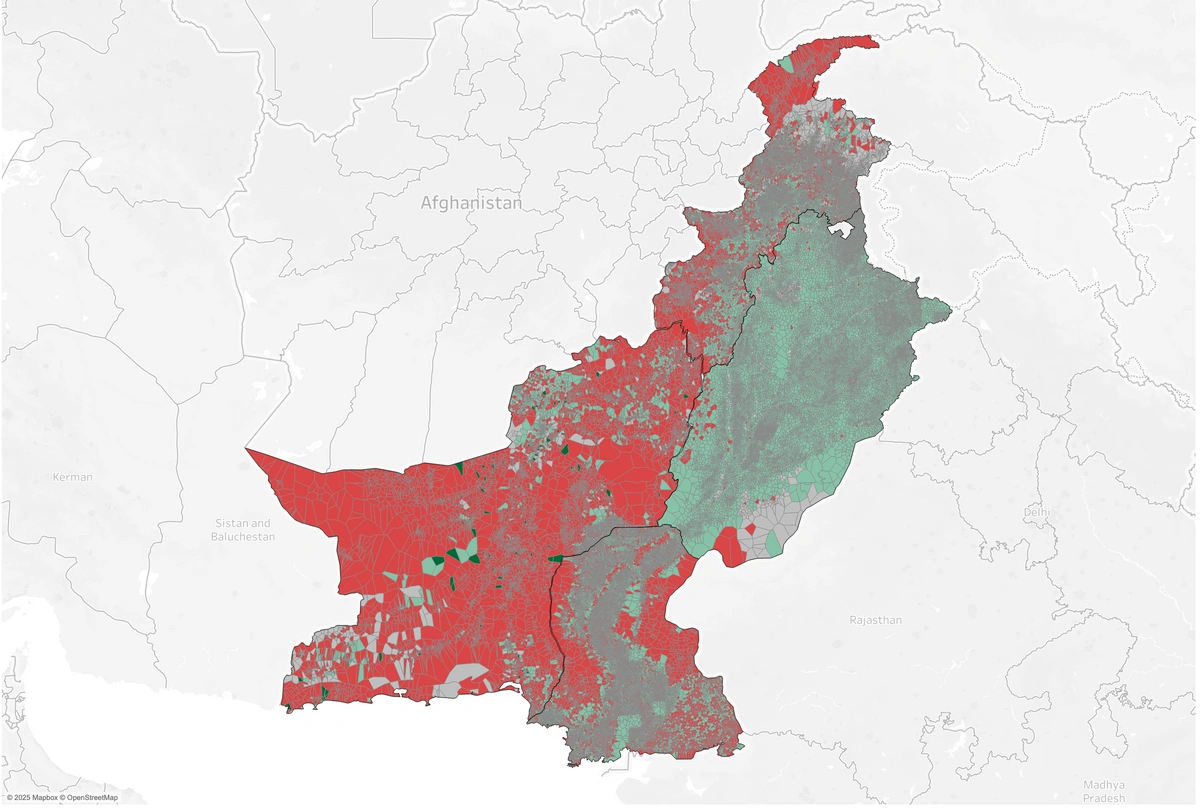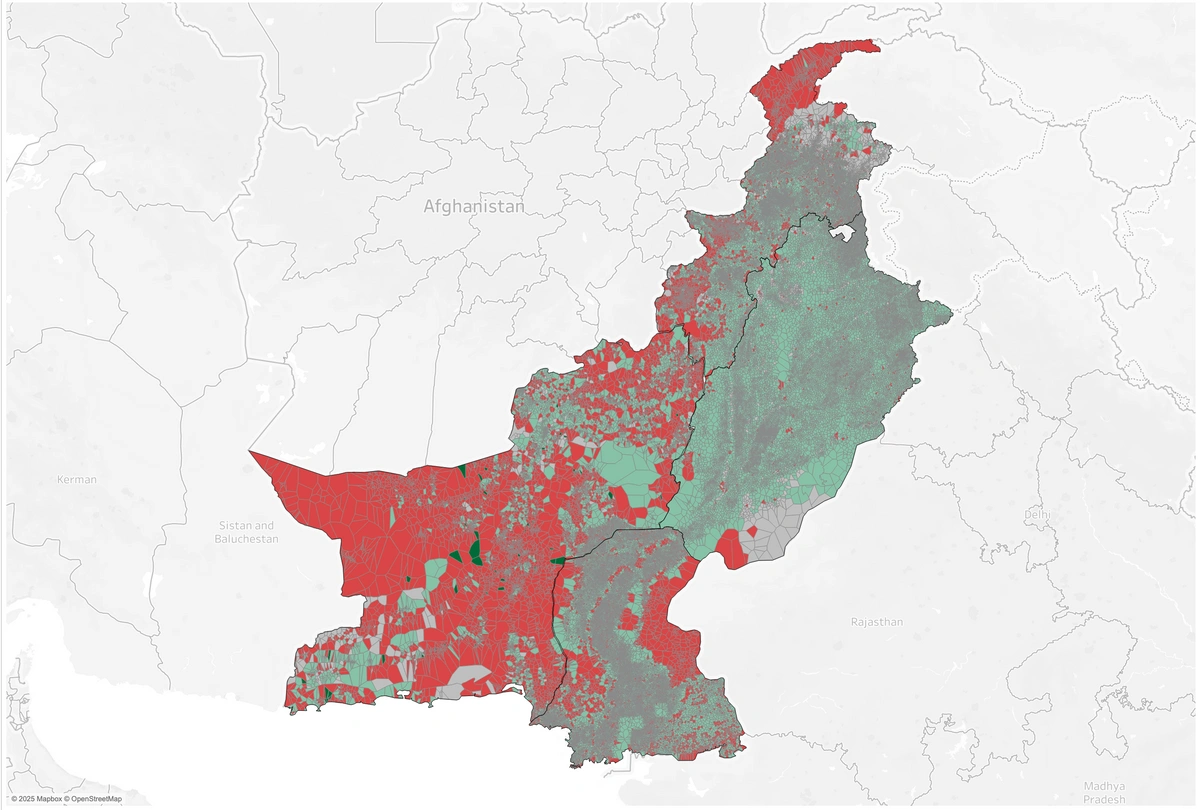
What good is data if we can’t see what’s working, or where the money’s going?
In 2022, Dr. Azra Pechuho, Minister of Health in Sindh, Pakistan, reviewed data suggesting maternal health facilities across the province were functioning well. But that wasn't the reality. A single photo showed a derelict labour room—one that was reporting fifty deliveries per month. The image laid bare the gap between what was reported and what was real, and was the catalyst to launching a new independent monitoring system in Sindh.
This story is just one example of how across Africa and Asia, governments can rarely see where their money is going, or if citizens are receiving the right services. In the second part of our Adversity as a Driver series, we explore how ministries can achieve rapid progress by turning data into action.
Lesson 1: Identify Blind Spots
While many countries track vaccination coverage, this alone doesn't tell them how to increase it.
To support citizens more effectively, countries must be able to monitor if vaccinators have shown up to vaccinate citizens, and see if vaccines are still in stock. There's no one-size-fits-all approach. While some countries lack a structured approach to monitoring health facilities, others rely on outdated or overly complex tools that don't give leaders what they need. This means we don't know if change is happening. And it makes it harder to learn and stay accountable.
But here's the good news: countries can strengthen their health systems using existing resources. That's what Dr. Azra Pechuho, Minister of Health, did in Sindh, Pakistan. She led the launch of an independent monitoring system in 2022, deciding which indicators would be tracked, and designing a survey for data collection. Within months, independent monitors collected regular data from 1,950 health facilities across the province. Driving provincial performance reviews, this data enables 80% of labour rooms to be fully functional today, compared to just 3% before. And that was done by spending less than 0.05% of the health budget on monitoring.
Because by knowing where to look and what to act on, countries can drive meaningful change for citizens, without additional resources.
Lesson 2: Act Fast and Create a Culture of Data Use
Traditional monitoring systems often fail to help managers spot blockers, but being unable to raise these issues while they still matter can be just as harmful.
Having simple, high-quality tools that track a few critical indicators in real time—like staff and medicine availability—is crucial. Instead of duplicating efforts, we work with existing frontline staff, who update checklists or surveys as part of their daily routines. This keeps costs low while generating reliable, timely data. With actionable data produced within just 2–3 hours of submission, covering 90–95% of facilities of communities, managers can spot problems early and fix them quickly.
In Sokoto, Nigeria, the government launched routine health facility monitoring in October 2024. Within months, the availability of many medicines increased across the province, showing what's possible with speed. Likewise, in Ethiopia, a basic smartphone app with real-time tracking abilities helped staff identify 283 broken fridges. Once repaired, these fridges enabled the delivery of 250,000 vaccine doses.
Because when it comes to collecting and using data, being simple and fast beats being complex and late.
Lesson 3: Visualise Progress Clearly
Too often, managers are left to rely on outdated, paper-based plans that show where teams are supposed to go, but not whether they get there, how far communities are, or if key areas get missed. This lack of visibility destroys accountability and leads to large gaps in vaccination coverage.
As Saad Rehman, Data Analyst Lead for Afghanistan and Pakistan, puts it: “Visual tools are critical to turning data into something truly actionable.”
By layering data from vaccinators who visit local communities onto digital maps, we've helped local teams move from paper plans to real-time delivery tracking. In Pakistan, a dashboard maps each facility and its surrounding communities, with simple colour-coded indicators showing which areas have been reached (green) and which haven't (red). This shift enabled the proportion of communities being visited by a vaccinator at least once per month to increase by almost 23% from July 2024 to May 2025.
Clear visuals don't just show the plan—they reveal the gaps, guide the work, and drive results.
July 2024: 58% of communities across Pakistan are visited by a vaccinator at least once per month.
May 2025: 75% of communities across Pakistan are visited by a vaccinator at least once per month.
Lesson 4: Turn Insight into Action
Without a structured way to review and act on insights, frontline teams lose focus, managers miss early warning signs, and communities continue to be overlooked.
That's why reviews must be at the heart of any data-led approach. We work with governments to establish regular reviews—ideally monthly—that bring together managers, supervisors, and frontline teams to identify real problems and agree on next steps. These sessions use data not as an end in itself, but as a tool to surface challenges and guide action.
In the DRC's Mashako Plan, designed to raise immunisation coverage, these kinds of structured reviews helped drive rapid improvements. The number of immunisation sessions nearly doubled from around 14,900 per month in 2018 to over 28,000 in 2021, because data was actively used to spot gaps and respond in real time.
With the right routines, data doesn't sit on a shelf. Instead, it fuels momentum and results.
In Summary: What We've Learned
Improving data systems shouldn't be seen as a cost to the system. It makes everything else work faster and more efficiently.
Ensuring better data use is about:
-
Uncovering the truth on the ground. Focus on a few critical indicators that show what's really happening.
-
Acting while it still matters. Use simple, real-time tools to track performance monthly and fix problems fast.
-
Making progress visible. Use dynamic, visual tools to help teams act on data.
-
Turning data into decisions. Build regular routines that keep everyone focused and accountable.
Because in tough settings, data isn't just information. It's the lever for lasting change.
For more on driving change for citizens without big spending, see what our Head of Partnerships, Ahmed Razzak, says about building political commitment.




